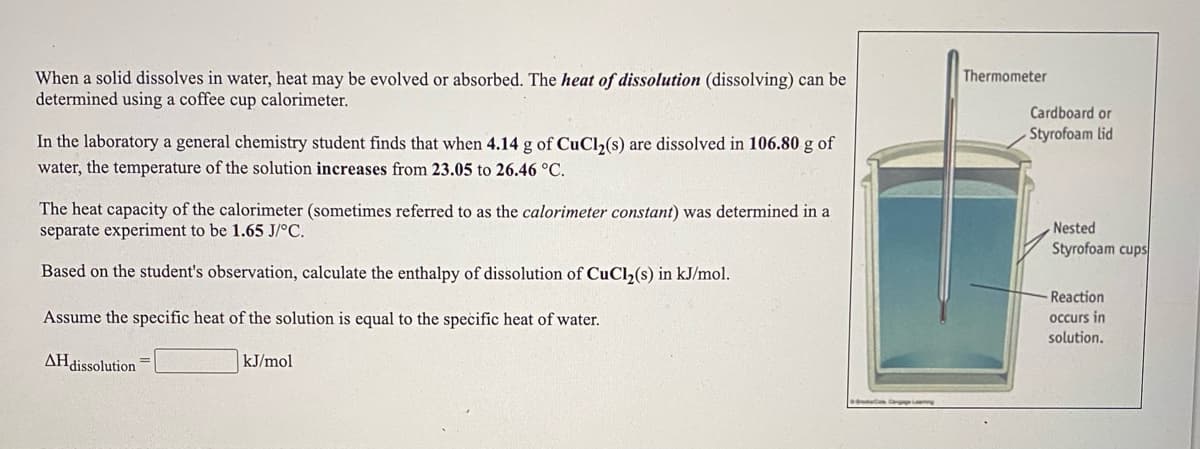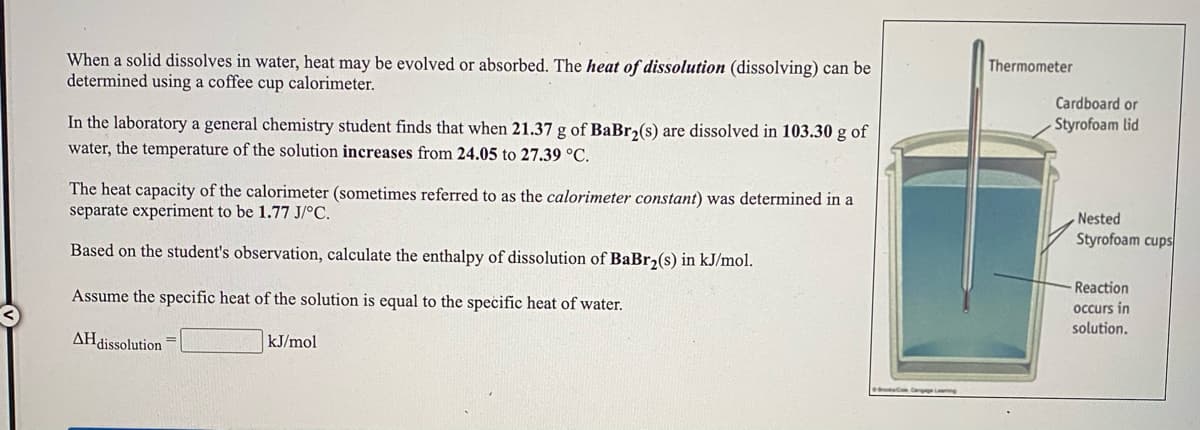When a solid dissolves in water, heat may be evolved or absorbed. The heat of dissolution (dissolving) can be determined using a coffee cup calorimeter. Thermometer Cardboard or Styrofoam lid In the laboratory a general chemistry student finds that when 4.14 g of CuCl,(s) are dissolved in 106.80 g of water, the temperature of the solution increases from 23.05 to 26.46 °C. The heat capacity of the calorimeter (sometimes referred to as the calorimeter constant) was determined in a separate experiment to be 1.65 J/°C. Nested Styrofoam cups Based on the student's observation, calculate the enthalpy of dissolution of CuCl2(s) in kJ/mol. Reaction Assume the specific heat of the solution is equal to the specific heat of water. occurs in solution. AHdissolution= kJ/mol
When a solid dissolves in water, heat may be evolved or absorbed. The heat of dissolution (dissolving) can be determined using a coffee cup calorimeter. Thermometer Cardboard or Styrofoam lid In the laboratory a general chemistry student finds that when 4.14 g of CuCl,(s) are dissolved in 106.80 g of water, the temperature of the solution increases from 23.05 to 26.46 °C. The heat capacity of the calorimeter (sometimes referred to as the calorimeter constant) was determined in a separate experiment to be 1.65 J/°C. Nested Styrofoam cups Based on the student's observation, calculate the enthalpy of dissolution of CuCl2(s) in kJ/mol. Reaction Assume the specific heat of the solution is equal to the specific heat of water. occurs in solution. AHdissolution= kJ/mol
Chemistry: Principles and Practice
3rd Edition
ISBN:9780534420123
Author:Daniel L. Reger, Scott R. Goode, David W. Ball, Edward Mercer
Publisher:Daniel L. Reger, Scott R. Goode, David W. Ball, Edward Mercer
Chapter5: Thermochemistry
Section: Chapter Questions
Problem 5.62QE: A 50-mL solution of a dilute AgNO3 solution is added to 100 mL of a base solution in a coffee-cup...
Related questions
Question

Transcribed Image Text:When a solid dissolves in water, heat may be evolved or absorbed. The heat of dissolution (dissolving) can be
determined using a coffee cup calorimeter.
Thermometer
Cardboard or
Styrofoam lid
In the laboratory a general chemistry student finds that when 4.14 g of CuCl2(s) are dissolved in 106.80 g of
water, the temperature of the solution increases from 23.05 to 26.46 °C.
The heat capacity of the calorimeter (sometimes referred to as the calorimeter constant) was determined in a
separate experiment to be 1.65 J/°C.
Nested
Styrofoam cups
Based on the student's observation, calculate the enthalpy of dissolution of CuCl,(s) in kJ/mol.
Reaction
Assume the specific heat of the solution is equal to the specific heat of water.
occurs in
solution.
AHdissolution
kJ/mol

Transcribed Image Text:When a solid dissolves in water, heat may be evolved or absorbed. The heat of dissolution (dissolving) can be
determined using a coffee cup calorimeter.
Thermometer
Cardboard or
In the laboratory a general chemistry student finds that when 21.37 g of BaBr,(s) are dissolved in 103.30 g of
water, the temperature of the solution increases from 24.05 to 27.39 °C.
Styrofoam lid
The heat capacity of the calorimeter (sometimes referred to as the calorimeter constant) was determined in a
separate experiment to be 1.77 J/°C.
Nested
Styrofoam cups
Based on the student's observation, calculate the enthalpy of dissolution of BaBr2(s) in kJ/mol.
Reaction
Assume the specific heat of the solution is equal to the specific heat of water.
occurs in
solution.
AHdissolution =
kJ/mol
Expert Solution
This question has been solved!
Explore an expertly crafted, step-by-step solution for a thorough understanding of key concepts.
Step by step
Solved in 2 steps with 4 images

Knowledge Booster
Learn more about
Need a deep-dive on the concept behind this application? Look no further. Learn more about this topic, chemistry and related others by exploring similar questions and additional content below.Recommended textbooks for you

Chemistry: Principles and Practice
Chemistry
ISBN:
9780534420123
Author:
Daniel L. Reger, Scott R. Goode, David W. Ball, Edward Mercer
Publisher:
Cengage Learning

General Chemistry - Standalone book (MindTap Cour…
Chemistry
ISBN:
9781305580343
Author:
Steven D. Gammon, Ebbing, Darrell Ebbing, Steven D., Darrell; Gammon, Darrell Ebbing; Steven D. Gammon, Darrell D.; Gammon, Ebbing; Steven D. Gammon; Darrell
Publisher:
Cengage Learning

Chemistry for Engineering Students
Chemistry
ISBN:
9781285199023
Author:
Lawrence S. Brown, Tom Holme
Publisher:
Cengage Learning

Chemistry: Principles and Practice
Chemistry
ISBN:
9780534420123
Author:
Daniel L. Reger, Scott R. Goode, David W. Ball, Edward Mercer
Publisher:
Cengage Learning

General Chemistry - Standalone book (MindTap Cour…
Chemistry
ISBN:
9781305580343
Author:
Steven D. Gammon, Ebbing, Darrell Ebbing, Steven D., Darrell; Gammon, Darrell Ebbing; Steven D. Gammon, Darrell D.; Gammon, Ebbing; Steven D. Gammon; Darrell
Publisher:
Cengage Learning

Chemistry for Engineering Students
Chemistry
ISBN:
9781285199023
Author:
Lawrence S. Brown, Tom Holme
Publisher:
Cengage Learning

Chemistry
Chemistry
ISBN:
9781305957404
Author:
Steven S. Zumdahl, Susan A. Zumdahl, Donald J. DeCoste
Publisher:
Cengage Learning


Chemistry: An Atoms First Approach
Chemistry
ISBN:
9781305079243
Author:
Steven S. Zumdahl, Susan A. Zumdahl
Publisher:
Cengage Learning